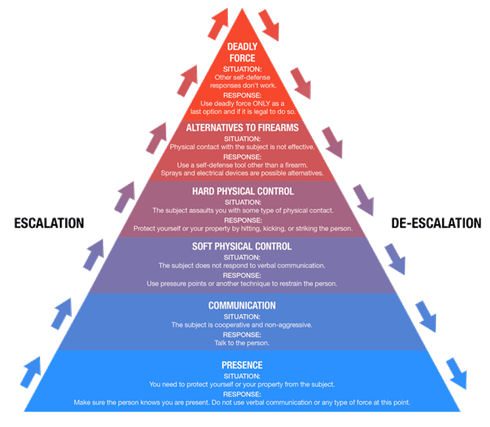This is the fourth in a multi-article series on Components of Personal Defense. In this article we will delve deeper into components of the fight; specifically, the development of a personal defensive paradigm, the legal use of force, and the force continuum.
As citizens, we are governed by a set of rules. Many of those rules are commonly understood interpersonal actions, like hitting someone out of the blue is unacceptable behavior. Then there are other rules that society has written down that governs our actions, like the speed limit on the highway. In judicial terms, the first set of rules is called common law and the second set is called statutory law. It is these laws that collectively “frame” our actions when it comes to the use of force and defensive actions. Knowing these laws is critical to understanding acceptable actions when using force and developing our own personal defensive paradigm.
Here I have introduced a new concept; the personal defensive paradigm. The definition of a paradigm is a model. So, a personal defensive paradigm is the application of your specific Mindset, Knowledge, Skills, and Capability (discussed in the previous article) to a defensive situation. A personal defensive paradigm is not static. It must be capable of changing, growing, and flexing based on training and the specific engagement. For example, you may train in knife fighting but, due to Common and Statutory law, if you are not presented with an eminent threat of death, great bodily harm, or sexual assault, you are not permitted by law to use that skill and tool. Thus, while your personal defensive paradigm includes the knife, it may be inappropriate and thus your defensive paradigm needs to flex with the situation.
A common model is called the Continuum of Force. This model describes the different levels of force and outlines the appropriate response to that force. A diagram of that model is presented below.

As we discussed in an earlier article, an attack can range from verbal to deadly. The engagement can and often does encompass multiple levels of force. The engagement may start verbal and escalate to pushing, followed by punching, finally escalating to a gun being drawn. Understanding these levels of force and being able to manage through each level is critical to successfully prosecuting the engagement.
So, as we start the think about developing our personal defensive paradigm, we need to keep in mind all the levels of force and develop skills and strategies to deal with an opponent at each level. We need to develop the skills not only to fight but also to de-escalate when the situation provides the opportunity. Remember, the easiest fight to win is the one we don’t fight.
I hope this has given you some things to think about. If you have friends or know of someone that would benefit from these articles, feel free to pass them along. Wake Firearms Training classes can be found on our web site at www.wakefirearmstraining.com. And as always, if you have questions or comments please reach out to me at wakefirearmstraining@mindspring.com.
Train Hard! Stay Frosty! Never Give Up!
John Neblett